HIGHLIGHTS
PROGRAM UPDATES
WoodWorks Portfolio an Indicator of Mass Timber Growth Think Wood Targets Contractors with Pro-Wood Messaging During Deck Season AWC Launches Updated Connection Calculator Think Wood Promotes Timber in the City Design ContestINDUSTRY NEWS
Residential Remodeling Index Continues on Positive Trend Metrostudy’s Q3 2019 Housing Forecast Warns of Recession Forest Proud Showcases CLT’s Personal Impact New UN Climate-Change Report Stresses Importance of Forests CLT – The Concrete of the Future? The Rise and Realities of Build-to-Rent Single-Family Homes Environmental Defense Fund Backs CLT Milwaukee’s Ascent Timber Tower to Add Stories Beautiful CLT High School Opens in Connecticut Mass Timber Enjoys Global Reach and Appeal Due to Environmental Benefits Technology Emerges as Key Input Toward Sustainably Managing America’s Forests CLT Messaging Reaches Diverse Audience Via ‘Outside’ Magazine Chief Carpenter Voices Support for Sidewalk Labs’ Mass Timber Vision in Toronto MEC Flagship Store Showcases CLT, Evokes Outdoors 10-Story Mass Timber Building in Minneapolis Near GroundbreakingProgram Updates
WoodWorks Portfolio an Indicator of Mass Timber Growth
WoodWorks’ vice president of operations, Bill Parsons, recently penned an article in The Merchant Magazine that chronicles the tremendous growth of mass timber in the United States, including within WoodWorks’ own portfolio. In 2015, WoodWorks technical staff supported a handful of mass timber building projects. That number grew to 158 projects in 2017 and 219 projects in 2018. These are in addition to approximately 545 other mass timber buildings that were completed or under design during the same period without WoodWorks’ support.
Parsons cites mass timber’s demonstrated performance as being the primary enabler of its growth in the U.S. market. Time and again, mass timber has met or exceeded code requirements related to fire, seismic activity, and acoustics. This performance data is what has led to a growing number of both code and policy changes that are facilitating the use of mass timber in buildings and projects that were once unavailable to wood. Coupled with the design and building community’s growing expertise in mass timber—brought about at least in part by WoodWorks’ free education offerings and online resources—mass timber is poised for even more growth.
Read Parsons’ article here.
Think Wood Targets Contractors with Pro-Wood Messaging During Deck Season

Like many in the design-build community, decking contractors are known to rely on peer relationships, client requests, and online sources to stay current with the latest trends in decking and outdoor living. To ensure that wood’s value proposition was front and center among contractor audiences during this year’s decking season, Think Wood ran targeted social media ads to promote wood and create engagement with Think Wood’s other online resources. In August alone, paid social media advertising created over 826,000 impressions and drove 5,617 clicks to Think Wood’s website. Facebook was the most effective channel among residential contractors -Twitter second – with click-throughs on par with or exceeding the industry average.
Think Wood’s Outdoor Oasis post was the top performer in terms of driving qualified traffic to Think Wood’s website, generating 1,271 clicks.
AWC Launches Updated Connection Calculator
Connections are critical to a building’s structural integrity, yet deciphering codes to ensure compliance can be tedious and time-consuming for designers and code officials alike. To make the task easier, the American Wood Council (AWC) has released an updated version of its popular Connection Calculator.
Based on provisions found in AWC’s National Design Specification® (NDS®) for Wood Construction, the Connection Calculator offers an easy-to-use, app-based approach to calculate capacities for single bolts, nails, and lag and wood screws; determine lateral and withdrawal connection values, adjusting for temperature, moisture, varying load durations, and end grain; and calculate single- and double-shear capacity and wood-to-wood, -concrete, or -steel connections. For connections loaded in shear, the calculator presents results for each of the NDS®-prescribed yield modes. The updated calculator also incorporates several new connection provisions, including for cross laminated timber (CLT) and post-frame ring shank nails.
The Connection Calculator is among several free, technology-enabled applications developed by AWC to help new and existing buildings to comply with the latest building codes and standards. You can download the Connection Calculator and other AWC apps at https://www.awc.org/codes-standards/calculators-software.
Think Wood Promotes Timber in the City Design Contest
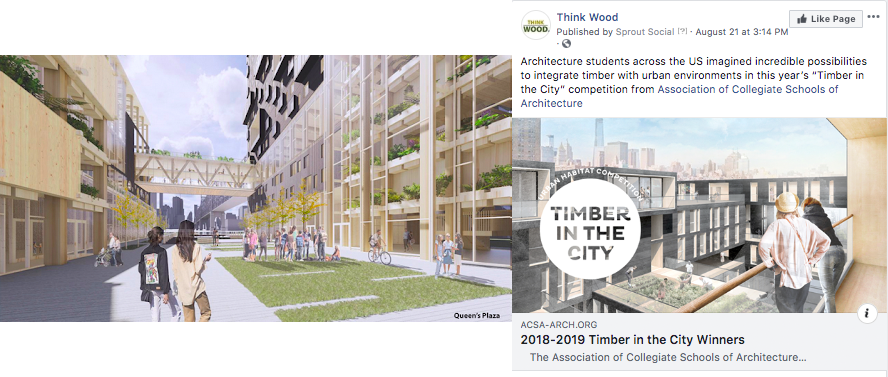
Think Wood was proud to support the 2019 Timber in the City Urban Habitats Competition by leveraging its extensive contacts to increase traditional and social media outreach. This year’s competition was organized by the Association of Collegiate Schools of Architecture (ACSA), the Binational Softwood Lumber Council (BSLC), and Parsons School of Design, and it received nearly 1,000 entrants from architectural students and faculty.
Now in its third year, the competition continues to challenge participants to interpret, invent, and deploy various methods of wood design and construction on a real site—this time, a mid-rise, mixed-use complex near New York City’s Queensborough/Ed Koch Bridge. The design had to include affordable housing, a large community wellness facility, and an early childhood education center.
The winner of this year’s competition was Aperture, submitted by a team from the University of Maryland, which the jury cited for its innovative and intelligent use of timber construction techniques.
Think Wood’s promotion of the competition garnered reposts in Archinect, Bustler, and Informed Infrastructure, with interest expressed by PRISM, Dwell, Bisnow, and Construction Dive. Think Wood will showcase entrants’ innovative designs via social media throughout September and October.
Read more about the competition here.
Industry News
Residential Remodeling Index Continues on Positive Trend
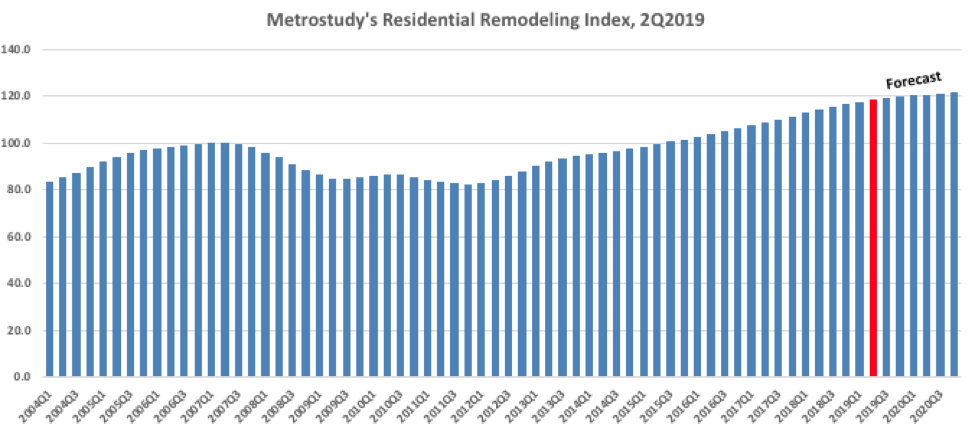
According to Metrostudy’s national Residential Remodeling Index (RRI) for the second quarter of 2019, the remodeling and replacement industry’s outlook remains positive despite expectations of an increasingly tight housing market.
The RRI increased to a new high of 118.3, which represents a 3.4% gain from one year prior and a 0.7% jump from the first quarter of 2019. The RRI has now experienced 29 consecutive quarters of year-over-year gains since national remodeling activity bottomed in 2011. The index reports that 380 metropolitan statistical areas are expected to see growth in project volume in 2019, at an average rate of 3.1%.
Metrostudy continues to forecast growth for the next several years; however, growth is expected to slow because of lower housing turnover and less new home construction. The RRI is expected to average year-over-year increases of 2% in 2020 and 2.4% in 2021.
Read more about the 2019 Q2 RRI here.
Metrostudy’s Q3 2019 Housing Forecast Warns of Recession
Metrostudy’s most recent quarterly housing forecast webinar echoed growing sentiment among economists that recession is increasingly likely for the U.S. economy starting in the latter part of 2021 into 2022, based on established precursors including employment and job loss. Metrostudy’s chief economist, Mark Boud, stressed that the forthcoming recession will not be led by housing, as current levels of new home building and stricter lending standards will avoid a repeat of the circumstances that brought on the 2007-2008 recession.
Metrostudy’s quarterly forecast also reduced the number of expected housing starts over the next five years, based on high labor costs, tight labor markets, and increasing material costs. This is despite high demand, especially at the low end of the market. These factors will combine to keep prices high.
In addition to the national outlook, the webinar also took a closer look at housing trends and forecasts for the Phoenix, Las Vegas, Salt Lake City, and Denver metro areas.
Listen to the entire quarterly forecast here.
Forest Proud Showcases CLT’s Personal Impact
In Forest Proud’s most recent video, celebrated architect Susan Jones of atelierjones llc discusses why she believes so strongly in specifying mass timber. Jones was among the early adopters of CLT in the United States, going so far as to specify it when designing and building her own home. She and her team continue to choose mass timber for its performance value, beauty, and, perhaps most importantly for Jones, its role in solving global climate change.
Watch the video here.
New UN Climate-Change Report Stresses Importance of Forests

The United Nations’ Intergovernmental Panel on Climate Change (IPCC) recently issued a new special report—Climate Change and Land—that will serve as a key scientific resource for global meetings on climate change, including the Conference of the Parties of the UN Convention to Combat Desertification in September and the UN Framework Convention on Climate Change Conference in December.
Compiled by 107 leading scientists from 52 countries, the wide-ranging report looks at the interactions between climate change and land use, land degradation, desertification, and food security, as well as management responses and pathways that can limit warming. Combinations of reforestation, afforestation, reduced deforestation, and bioenergy are common themes across the management pathways.
The report singles out sustainable forest management for its ability to maintain and improve forest carbon stocks and maintain forest carbon sinks, including transferring carbon to harvested wood products. Wood products can store carbon over the long term and reduce emissions in other sectors through material substitutions, which makes them a viable trade-off to the short-term decrease in forest biomass caused by harvesting. Wood is the only widely used building material cited in the report as able to be part of the solution to a warming climate.
Read more here.
CLT – The Concrete of the Future?
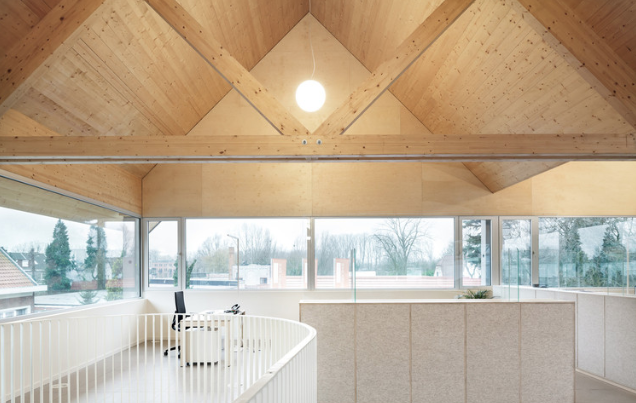
ArchDaily recently interviewed Jorge Calderón, an industrial designer and CRULAMM manager, to talk about CLT’s many uses, comparative advantages over concrete, and the promising opportunities that CLT can provide to the design and building community in the future.
Calderón believes that CLT can serve as the concrete of the future in many circumstances, as it delivers the same or greater structural strength as reinforced concrete while offering greater flexibility. Calderón notes that 1 cubic meter of concrete weighs approximately 2.7 tons, while 1 cubic meter of CLT weighs only 400 kg, while offering the same resistance. Calderón also iterates CLT’s well-documented environmental and carbon footprint advantages over concrete.
Read more about the case for CLT as the primary building material of the future here.
The Rise and Realities of Build-to-Rent Single-Family Homes
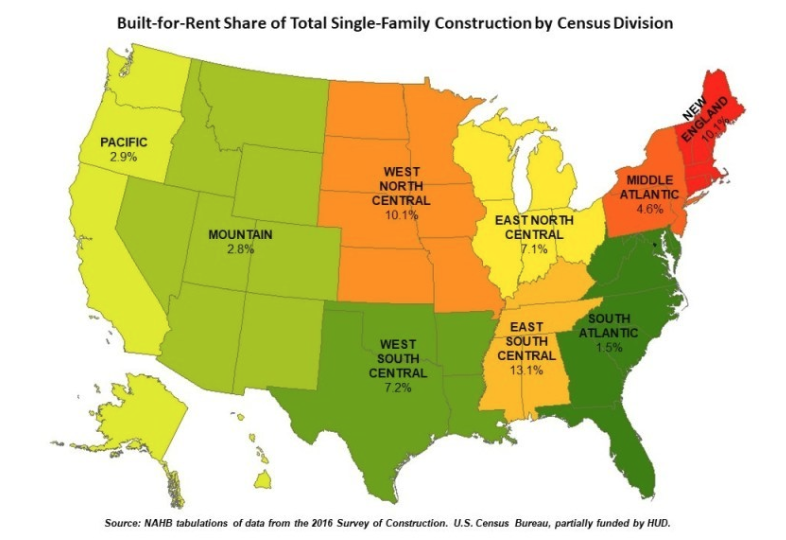
Metrostudy recently turned its attention to one of residential real estate’s hottest trends: single-family homes built-for-rent (SFBFR). An estimated 15 million American households currently rent single-family homes rather than multiunit apartments, according to National Multifamily Housing Council data, representing 35% of all renting households. Investors and builders are taking note, with one in 20 new single-family homes now expressly built for the purpose of renting—almost twice the historical share.
According to comparative analysis of census data undertaken by the National Association of Home Builders, new SFBFR homes are more likely to be:
- smaller, with fewer bedrooms and bathrooms.
- a single-story building, and likely attached.
- located on a smaller lot.
- wood-framed with vinyl siding exterior.
SFBFR are also more likely to have a smaller construction permit value but have many units with values higher than $300,000 – and take longer to build on average. The largest share of SFBFR construction is found in the West South Central Census division, which comprises Texas, Oklahoma, Arkansas, and Louisiana.
Read more here.
Environmental Defense Fund Backs CLT
The Environmental Defense Fund (EDF) believes in the promise of CLT and mass timber to help restore American forests. The SLB has long covered the ongoing and exponential growth of CLT in global and, more recently, American markets. In the EDF’s view, if the market for CLT continues to grow and expand, it can help restore the health of U.S. forests and sustainably reduce the risk of wildfire. Analysts estimate that CLT’s market potential in the United States is approximately $4 billion, but sales could eventually exceed that.
Historically, small-diameter trees and understory brush have been converted to low-value wood chips or pulp, if harvested at all. However, CLT offers rural producers and forest stewards with a much higher-value product option and, thus, tangible financial incentives to restore and sustainably manage forests, while also removing fuel load.
Read more about the EDF’s views of CLT here.
Milwaukee’s Ascent Timber Tower to Add Stories
Wisconsin’s Daily Reporter, a construction and real estate news outlet, recently brought its readers up to date on Ascent, Milwaukee’s 21-story-tall wood tower, which is being developed by New Land Enterprises.
Milwaukee officials approved the project as a 21-story tower, but Ascent’s project developers are currently modifying the plans to add two floors. At 21 stories, Ascent would become the largest mass timber office structure in the United States surpassing Minneapolis’s T3. If approved at 23 stories, Ascent will become the second tallest mass timber building in the world, behind a 24-story timber tower in Austria.
Coastal markets have so far been quicker to adopt mass timber, including in tall structures; thus, both Ascent and T3 create important case studies and opportunities for learning and replication in the Midwest. Construction of Ascent will begin as early as spring 2020.
Read more about CLT’s role in Ascent here.
Beautiful CLT High School Opens in Connecticut
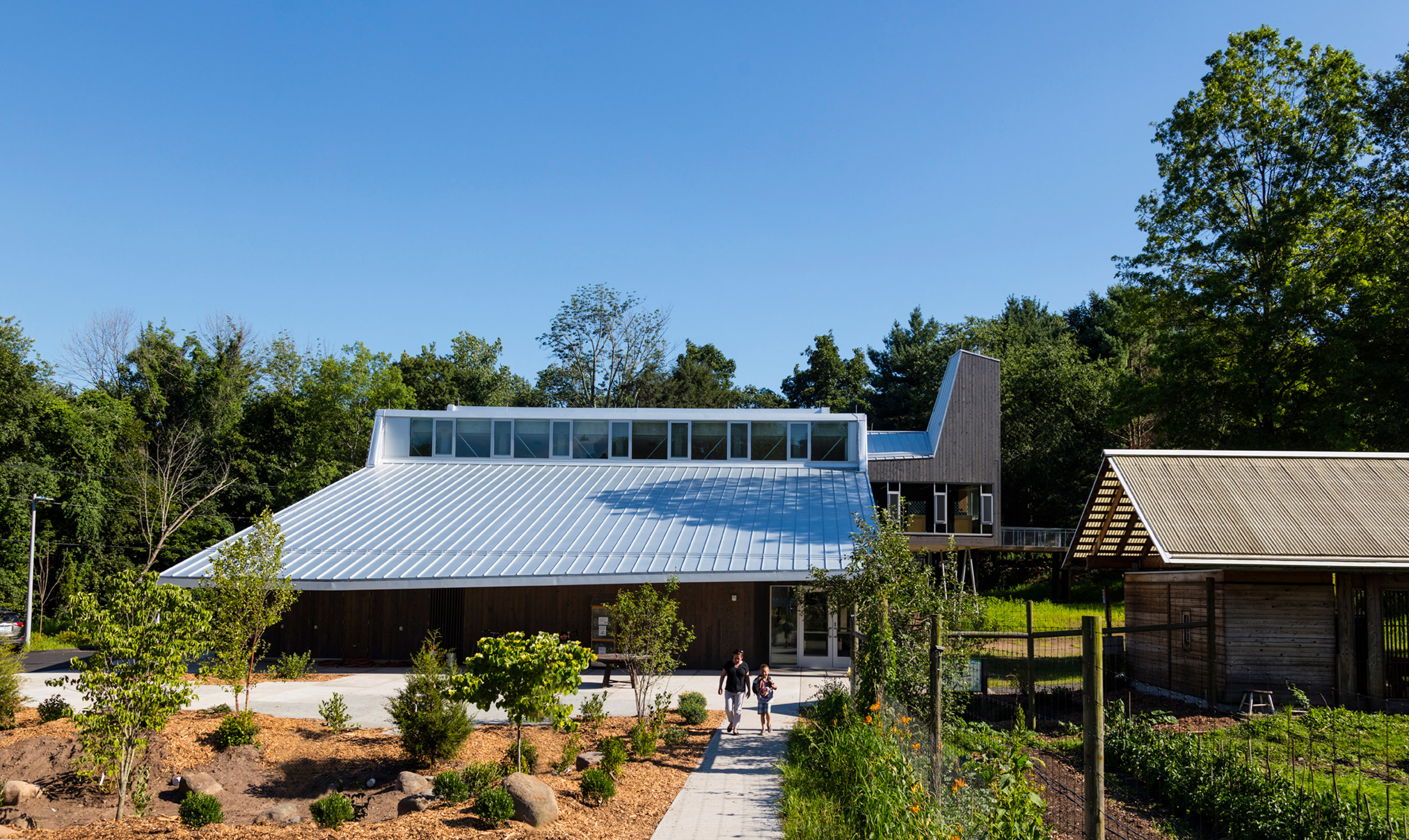
When tapped to design an extension for a nearby, environment-focused charter high school, New Haven–based firm Gray Organschi Architecture turned to CLT as the obvious choice to integrate sustainable design practices consistent with the school’s mission.
The 14,760-square-foot addition houses a gymnasium, laboratories, communal areas, and classrooms and, through the use of CLT, serves as a complement to the campus’ agricultural fields, forests, and wetland habitat. Other sustainable features include ample natural lighting, rainwater treatment, passive ventilation, and on-site energy production via geothermal wells.
See photos of the completed project here.
Mass Timber Enjoys Global Reach and Appeal Due to Environmental Benefits
Reuters recently reported on the growing and worldwide adoption of taller mass timber buildings in response to environmental concerns and, more specifically, concrete’s large carbon footprint and negative environmental impacts. Thanks to innovations in engineered wood products and greater inclusion of these products in building codes, ever-taller wood structures are spreading across Europe, North America, and the Asia Pacific region. Structures in Amsterdam, Vancouver, and Tokyo are all vying to claim the title of world’s tallest.
According to Andy Buchanan, a professor of timber design at the University of Canterbury in New Zealand, “As tall timber buildings become more popular, the perceived disadvantages—fire safety, durability, and the supply chain—are being overcome with good design, excellent case-study buildings, and technology for engineered wood products.”
Read more about mass timber’s uptake around the world here.
Technology Emerges as Key Input Toward Sustainably Managing America’s Forests
A piece in the summer 2019 edition of Innovation and Tech Today takes a closer look at some of the technologies being deployed by the U.S. Forest Service (USFS) and forest industry to manage and protect American forests as long-term, renewable resources. USFS now widely uses technologies such as LiDAR, a remote-sensing method that uses light to measure distance and is useful in mapping forest canopy and underlying topography; DNA testing to chart biodiversity within forest ecosystems; and drones to gather data, including during wildfires.
The USFS continues to seek and invest in new technology development, appreciating the urgency for forests and other land uses to adapt to a rapidly changing climate. The USFS’s Wood Innovations Grants program is one example wherein the agency offers grants to support the creation and adoption of new technologies to promote and sustain forests’ biological and economic health.
Read more about the role of technology in managing forests here.
CLT Messaging Reaches Diverse Audience Via ‘Outside’ Magazine
Outside magazine highlighted CLT in a Big Ideas feature in its Sept. 10 issue. In addition to offering a history and primer on the material, Outside homed in on the prospective contribution of CLT to forest management and conservation as well as the contributions of organizations like WoodWorks in helping to promulgate CLT’s application. The author also noted several potential barriers to CLT’s growth, including the concrete industry’s recent, not always truthful, attack ads against wood, inaction on the part of policymakers to incentivize CLT’s use, and the need to better integrate the use of lower-quality wood instead of only conventional lumber sources.
Outside’s circulation is about 675,000 in print, with an additional 3.5 million unique page views online each month, thus bringing mass timber’s message to a broader and nontraditional audience.
Read more here.
Chief Carpenter Voices Support for Sidewalk Labs’ Mass Timber Vision in Toronto
In early September, Mike Yorke, the president of the Carpenters’ District Council of Ontario, published a commentary in the Toronto Sun outlining the economic and environmental benefits of mass timber and urged Toronto—and Canada as a whole—to embrace mass timber as the optimal building material of the future as proposed in Quayside development by Sidewalk Labs. As previously reported, Sidewalk Labs, a subsidiary of Google parent company Alphabet Inc., working in partnership with the public corporation Waterfront Toronto, recently put forward a transformational development plan for the 12-acre Quayside area on Toronto’s eastern waterfront. The plan calls for all the development’s structures—including ones as tall as 30 stories—to be built of mass timber.
Read Yorke’s commentary here.
MEC Flagship Store Showcases CLT, Evokes Outdoors
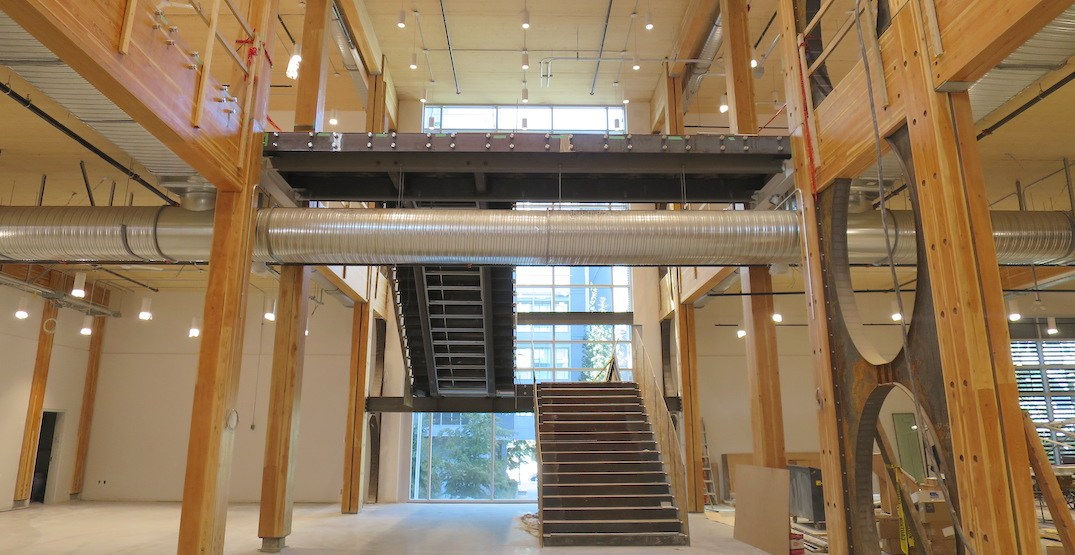
Construction is nearing completion of Canadian retailer Mountain Equipment Co-op’s (MEC) Vancouver flagship store in the Olympic Village district of Southeast False Creek. The three-story, approximately 60,000-square-foot building, owned by Beedie Development, features extensive use of CLT in what will become one of the largest applications of CLT in a commercial space to date.
CLT was deliberately selected to align with MEC’s green-oriented mandates, as well as its purpose as an outdoor apparel and equipment retailer. The CLT used in the store was manufactured from sustainably harvested, pine beetle–affected wood from British Columbia. The store is scheduled to open in early 2020.
Read more and see images of the store here.
10-Story Mass Timber Building in Minneapolis Near Groundbreaking
The Minneapolis Planning Commission has given the green light for a 10-story mass timber condominium project to move forward in the North Loop neighborhood of Minneapolis. Developer Todd Simning, working in partnership with developer and architect Colin Oglesbay, expects to break ground on the $65 million tower before the end of the year.
The developers chose PCL Construction as their contractor specifically for its experience in building with mass timber.
Read more about the project here.
Insights on the Competition
Investors Rachet Up Pressure on Cement Industry Over Climate Concerns
Investors are joining environmental groups, regulators, and lawmakers in pressuring cement producers to take more and transparent action to reduce their carbon footprints and help slow global warming. A coalition of money managers and investors with more than $33 trillion under management is requesting that several large European construction-material companies, including CRH Plc, LafargeHolcim Ltd, HeidelbergCement AG, and Compagnie de Saint-Gobain SA, set short-, medium-, and long-term targets to become carbon neutral by 2050, and to assign specific responsibility for climate change to a board committee or board member.
According to the International Energy Agency, the cement industry accounts for 7% of the Earth’s human-produced carbon dioxide. HeidelbergCement, for one, has already set net-zero emission targets for 2050, which it plans to achieve by cutting emissions and increasing carbon capture and recycling. Besides pressure from investors, the concrete industry is also facing rising prices because of Europe’s carbon markets, and it is expected to face stricter building and infrastructure regulations as countries take their own action to meet emissions targets.
Read more here.
Build with Strength Showcases Cement in Modular Construction

Build with Strength placed a full-spread ad in the August 2019 edition of Architect magazine, featuring the 17-story Davenport Grand Hotel in Spokane, Wash., which was built using modular construction. Similar to the use of modular construction in mass timber and other wood structures, these techniques created significant time savings and reduced waste for the project.
Industry Resources
FEA Housing Dashboard
Virginia Tech’s Monthly Housing Report
This monthly housing commentary report is a free service of Virginia Tech and is intended to help one gauge future business activity in the U.S. housing market.
July 2019 Reports (released in August 2019)
Part A: July Housing Commentary
Part B: July Economic Conditions

